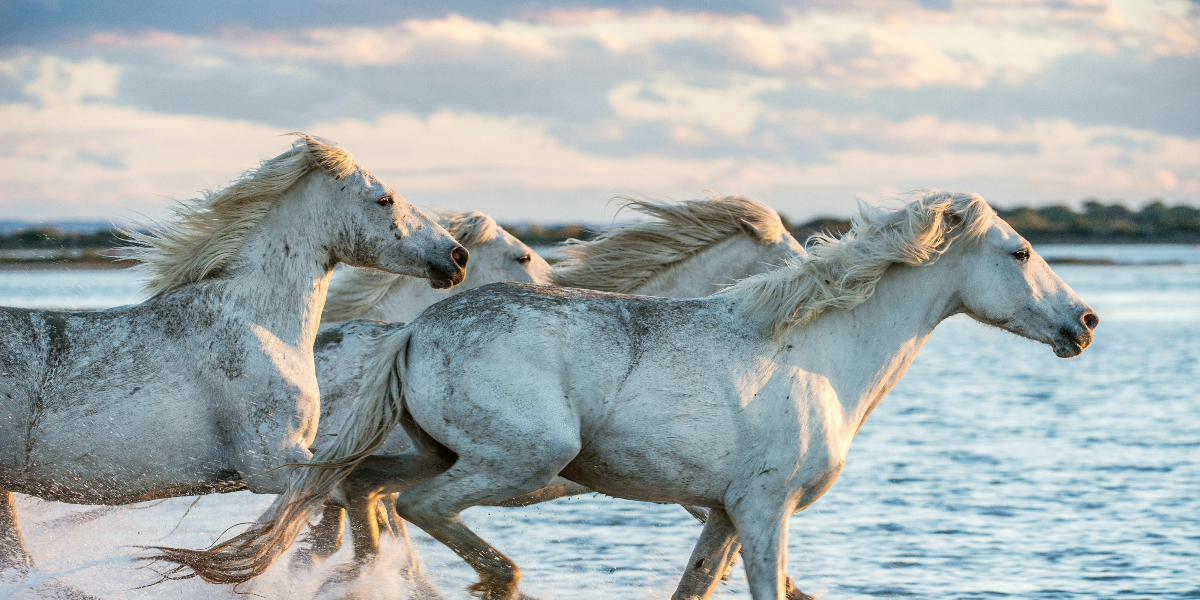Dr. Tim Winegard is a New York Times bestselling author of six books and an associate professor of history at Colorado Mesa University, where he is also the head coach of the men’s hockey team. His work has been covered by the New York Times, New Yorker, Economist, USA Today, Nature, Science, Smithsonian, Scientific American, and countless other media outlets. He has appeared on Netflix, CBS This Morning, PBS Nova, C-Span, Global News, BBC, CBC, TVO, CTV, and NPR. Winegard served as an officer in the Canadian and British Armies.
Below, Tim shares five key insights from his new book, The Horse: A Galloping History of Humanity. Listen to the audio version—read by Tim himself—in the Next Big Idea App.

1. Indo-European horsemen and the making of modern Eurasia.
The domestication of horses on the windswept grasslands of the Pontic-Caspian Steppe in Ukraine and southern Russia around 3500 BCE was nothing short of an Equine Revolution in transportation, traction, trade, and war.
Riding the first generations of domesticated horses, plundering Indo-Europeans spilled out of the Steppe and quickly overran the Eurasian expanse from the Atlantic Ocean through Europe and India to the western frontiers of China.
Beginning around 3000 BCE, the relatively egalitarian, peaceful, and gender-equal societies of Neolithic Europe (and the Indian subcontinent) were rapidly and completely replaced with the hierarchy, customs, genetics, and language of these mounted Indo-European marauders. This wholesale remodeling established a more militaristic, capitalist, male-dominated culture that has been both the bane and blessing of Europe and its (former) global empire for millennia.
As a result, Indo-European is now the ancestral language for roughly 3.7 billion people—or 46 percent of our global population. In addition, within a few generations, Indo-European DNA accounted for an astounding 40 to 50 percent of the total genetic fingerprint across Europe. More telling is that almost all European males have Y chromosomes from these mounted invaders. At the same time, between 60 to 90 percent of men now living in the Indian sub-continent can trace their patrilineal DNA (and the caste system) to colonizing Indo-European horsemen.
During their conquests, Indo-Europeans also introduced the smoking of psychoactive marijuana to Europe. Complimenting archeological evidence, during the third millennium BCE, derivatives of the Indo-European root word for cannabis, kanna, spread widely across Indo-European branch languages.
While blazing their way across Eurasia, mounted Indo-Europeans also kicked off a fashion revolution. There is a direct correlation between horseback riding and the origin and widespread adoption of pants. The oldest recovered pair of purposefully fashioned trousers, dating to 1300 BCE, belong to two trendsetting, mummified Indo-European horsemen unearthed (with cannabis paraphernalia) in the Tarim Basin of China’s western Xinjiang province.
In addition to propagating their language, genes, and male-dominated ethos, this transformative, history-defining “Indo-Europeanization” of Eurasia also dissem¬inated domestic horses, wool sheep, wagons, chariots, bronze, pot, and pants across a significant portion of the planet, with ripple effects that have not yet subsided.
2. The horse and the downfall of Indigenous plains peoples.
Contrary to popular belief, the wholesale adoption of the horse (following its reintroduction to the Americas by Columbus) by Indigenous peoples of the Great Plains (notably the Comanche and Lakota Sioux) was not a socio-cultural benefit. The horse corrupted the lives and societies of Indigenous peoples and facilitated their downfall and subjugation. The common perception of the horse as the sole positive and uplifting element of the Columbian Exchange for Indigenous peoples—fitting apologetically into narratives otherwise filled with disease, desolation, and death—is not accurate.
Horses had been absent from the Americas for roughly 10,000 years—long enough that from an environmental standpoint, they were as much an invasive species as cattle, smallpox, Europeans, and tumbleweed. The introduction of colonizing horses upended intricately evolved grassland ecologies, contributing directly to the collapse of bison populations. The sweeping adoption of an equestrian culture by Indigenous nations also undermined traditional military, economic, egalitarian, gender, and social conventions.
“The introduction of colonizing horses upended intricately evolved grassland ecologies, contributing directly to the collapse of bison populations.”
These were replaced with bison and fur-based export capital¬ism; divisive social, gender, and economic hierarchies; and unremitting in¬tertribal warfare, transforming the heart of the Prairies into a brutally contested war zone awash with the blood of bison, horses, and human beings. As a result, bison populations began to dwindle by the 1830s. To feed their bison-based economy, the Comanche harvested at least 280,000 animals annually, in peak years reaching 574,000.
Dwindling bison numbers were further pushed to the precipice of extinction by spiraling ecological pressures triggered by the introduction of horses and cattle, whose diet, including sparse water resources, overlapped with bison by 80 percent. From an estimated pre-Columbian population of sixty million, by 1890, only a few thousand bison remained. The battle for supremacy and survival in the American West was not just being played out among rival Indigenous peoples, settlers, and cavalrymen but also by cattle, horses, and bison. This cultural upheaval was compounded by waves of cascading disease.
The horse accelerated the delivery of deadly pathogens to which Indigenous peoples had no acquired immunity. From 1730 onward, an epidemic of smallpox (often escorted by other lethal pathogens) ripped across the plains every ten to twenty years, shattering Indigenous populations who entered the paternalistic and bleak reservation era.
3. The horse and the birth of Hollywood.
In 1872, former California governor and railroad magnate Leland Stanford made a wager with some friends. Although he had no visual proof, he was convinced that all four hooves of a horse were off the ground at the same time while galloping. His pals believed otherwise. Stanford’s two passions, aside from money and politics, were wine and horses. He owned two vineyards and breeding stables for racehorses at Palo Alto Stock Farm (now Stanford University, still known colloquially as “the Farm”).
Unlike the ancient Egyptians, who had sought an answer to this same question, new technology—and some ingenuity on the part of Eadweard Muybridge, an eccentric and unconventional English photographer hired by Stanford—finally caught up to the horse.
It was the embryonic age of photography, and each glass plate had to be wet-coated immediately prior to snapping a picture, significantly impacting shutter speeds. This made it impossible to take successive, rapid-fire shots. That is, impossible with only one camera.
“Hollywood began with horses and a bet at the racetrack down on the farm.”
On June 10, 1878, Muybridge set up a row of twelve single-lens cameras at twenty-seven-inch intervals on a track at Palo Alto against a white backdrop to contrast with the galloping dark horse named Sallie Gardner. Muybridge laid across the track a series of electromagnetic circuits and trip wires attached to the camera shutters to time the consecutive exposures to record a virtually instantaneous chronological sequence.
Muybridge printed the serialized photographs on a round glass plate. By spinning this disc on what he called his “zoopraxiscope,” which projected the images in a repeating loop on a screen, Muybridge, Stanford, and Sallie Gardner gave birth to the motion picture with the pioneering three-second clip dubbed The Horse in Motion.
Stanford also won the $25,000 bet and affluent bragging rights. All four feet of a horse are off the ground during each stride, collected under its barrel as it switches from “pulling” with the front legs to “pushing” with the back. And so, Hollywood began with horses and a bet at the racetrack down on the farm.
4. The Great Manure Crisis of 1894.
In 1894, New York City was sinking in shit. The metropolis and its three-and-a-half million residents were being swallowed by the surging contamination and accompanying communal health problems produced by their indispensable personal, public, and commercial transportation. Instead of greenhouse gases and climate change, the mounting pollution crisis took the shape of unimaginable piles of rancid manure produced by more than 200,000 urban horses and mules who donated upwards of 3,000 tons a day to the squalid streets of Gotham. Urban centers around the world were facing the same shitty situation.
London, for example, was bombarded by a daily output of 4,500 tons from 300,000 horses. Vacant lots, public parks, and alleyways accumulated heaping piles of manure reaching sixty feet. The trendy New York brownstone row houses with their elegant staircase stoops climbing to second-story parlors were purposefully built to rise above the streaming slurry of horse manure and urban muck. Adding to this atmosphere of urban disease and decay were thousands of dead and bloated horses left to rot in the filthy streets.
It is hard to believe that just over a century ago, horses were literally everywhere and used for everything. They were the heartbeat of commerce and transportation. A bird’ s-eye view of the planet would show the urban centers of humanity crawling with horses—and their fly-ridden manure
“The motorized solutions that saved us from horse pollution and manure piles in the twentieth century are now imperiling us with their own pollution in the twenty-first century.”
It was so abundant that the initial Ford factories used manure as a supplemental fuel source, burning through two thousand pounds a week. Horse droppings were used to manufacture the very machines that would depose the steadfast animal from its mantle of power. Or, to put it another way, one contamination was used to produce another contaminator. The motorized solutions that saved us from horse pollution and manure piles in the twentieth century are now imperiling us with their own pollution in the twenty-first century.
Currently, researchers have been developing technology to “recycle,” or convert, the methane in manure into hydrogen to power fuel cells for electric cars. The goal is to be able to run a car for a year from the annual excrement of one animal. As evidenced by the Great Manure Crisis of 1894 and our current struggle with the internal combustion engine, our primary modes of transportation have always had emission problems.
5. Horsepower and the Big Lie of blitzkrieg.
The unrivaled presence of horses on the Ger¬man front lines during the Second World War facilitated the overthrow of the Third Reich, which feigned mechanized superiority at the outbreak of war. Nazi blitzkrieg was just another bluff based on Adolf Hitler’s Big Lie. It was carefully crafted propaganda to hide the true vulnerabilities of an anemic and backward German military equipped for the last war while attempting to fight the next.
In truth, the Nazis had far more ponies than panzers. Blitzkrieg, as it turns out, was fueled not by oil but by oats. The German army that goose-stepped and galloped through Poland, Denmark, Norway, Belgium, the Netherlands, and France in 1939 and 1940 was only 15 percent mechanized at best. As motorized casualties mounted and German industry faltered, the horse was increasingly drafted into service.
With the German invasion of the Soviet Union in the spring of 1941, the inherent limitations of Hitler’s horse-drawn military became starkly exposed. The myth of blitzkrieg, and successive German army groups, evaporated at the gates of Leningrad, Moscow, the Caucasus, and Stalingrad. By 1944, more than 90 percent of the German military relied on hooves for transport. On the other hand, the American, British, and Canadian forces were fully mechanized, while Joseph Stalin’s Red Army was increasingly trending in that direction thanks to the unrivaled production of American industry.
A scene from the award-winning miniseries Band of Brothers serves as a poignant example. Following the unconditional German surrender in May 1945, Private David Webster is riding in the back of a truck, passing an endless line of dejected German prisoners, when he is suddenly overcome by a surge of anger and resentment. Webster, who left his English literature studies at Harvard University to enlist, seemingly vents years of repressed trauma by screaming, among a highly articulate string of obscenities, “Say hello to Ford! Say hello to General fucking Motors! Look at you! You have horses! What were you thinking?!”
Germany employed over a million more of these animals than in the previous war, thrusting almost three million horses into military service. Examining the outcome of the Second World War through this lens, it was precisely the heavy use of these horses by the Germans that helped Webster and his band of brothers win the war.
To listen to the audio version read by author Timothy Winegard, download the Next Big Idea App today:
































